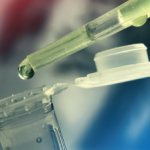Among other problems, Ms. Blake experienced nerve pain, vision issues and abdominal muscle spasms. She saw several neurologists before a rheumatologist finally diagnosed her with SPS—seven years after she sought medical care, the average time to diagnosis in SPS patients. Although neurologists are often the primary caregivers for people with SPS, rheumatologists can also aid in diagnosis and treatment. Ms. Blake notes that, in her experience, rheumatologists are “more out-of-the-box thinkers” and so may be of particular help with diagnosing rare conditions such as SPS.

Whitney Blake underwent HSCT in summer 2016 to treat her stiff person syndrome.
“I try to educate nurses, med students, interns, residents and doctors about the symptoms in hopes that they will recognize it in another patient, and perhaps we’ll get that average time of diagnosis down to a shorter period of time,” Ms. Blake explains. “That is important, because the longer you have the disease without being treated, and the longer it progresses, the worse off you will be.”
Even with proper diagnosis and treatment, Ms. Blake’s symptoms were progressing. As part of her research, Ms. Blake discovered the SPS clinical trial at Northwestern. “I was going downhill, and the doctors didn’t really have anything else except high-dose Cytoxan [cyclophosphamide]. So my doctors and I thought, we might as well get the stem cell transplant done.”
It’s difficult to research rare diseases, such as SPS. Outcomes for HSCT and SPS are still extremely limited. A 2014 case report from the Ottawa Blood and Marrow Transplant Program showed remission of symptoms in two patients with severe SPS who received autologous HSCT, using the same regimen used to treat patients with multiple sclerosis (MS).14
After an initial evaluation, Ms. Blake was accepted into the trial and went through the procedure in the summer of 2016. She considers herself fortunate that she did not have to make multiple appeals to her insurance company. “I did pretty well,” she says, crediting the excellent care that she received from her medical team at Northwestern. “It wasn’t as bad as I thought it would be.” She remains hopeful about the potential long-term benefits.
Ms. Blake thinks many doctors less familiar with HSCT are thinking about the risks of allogeneic transplants, not autologous transplants. “Here, you are using your own stem cells. This is much safer. Some neurologists are coming around to seeing this as a very good treatment for some MS patients, for example.”
